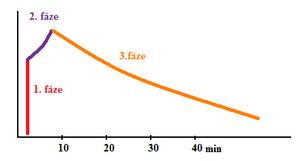Radionuclide examinations of the kidneys
Radionuclide examinations of the Kidneys focus on the evaluation of Kidney function, usually followed by other examinations of the urinary tract. According to the monitored values, we divide the examination into:
- dynamic scintigraphy - diuretic nephrography, evaluation of renovascular hypertension
- static scintigraphy.
Radio-pharmaceuticals[edit | edit source]
The choice of radiopharmaceutical depends on the examination method chosen. 99mTc labeled substances are used.
Radiopharmaceuticals in dynamic methods
Labeled DTPA, EDTA and MAG3 are used for dynamic renal scintigraphy. The typical routes of their excretion by the kidneys are used to monitor individual functional parameters.
99mTc-DTPA (diethylenetriaminepentaacetic acid) crosses the glomerular membrane and is filtered into the primary urine. Tubular secretion does not occur in other parts of the nephron. It can therefore be used to monitor glomerular filtration.
In contrast, 99mTc-MAG3 (mercaptoacetyltriglycine) enters the urine only by active secretion in the tubules and informs about the functional state of the tubules.
51Cr-EDTA (ethylenediaminetetraacetic acid) is chromium-labeled to prevent overlapping signals from other radiopharmaceuticals when performing renal clearance and other tests.
Radiopharmaceuticals in static methods[edit | edit source]
Static tests use substances that are taken up by the renal parenchyma but do not pass into the urine. The most commonly used is DMSA.[edit | edit source]
99m Tc-DMSA (dimercaptosuccinic acid) accumulates in tubule cells[edit | edit source]
.[edit | edit source]
Dynamic methods[edit | edit source]
They monitor the movement of the radiopharmaceutical in individual parts of the kidney (vessels → parenchyma → duct system). They are often used in kidney transplant patients to monitor their function. They do not require the administration of contrast agents that are nephrotoxic.[edit | edit source]
Determination of radiopharmaceutical clearance
Older methods with continuous infusion of radiopharmaceuticals are no longer performed today.
Examination by the sample method does not require urine collection. However, it is necessary to choose a radiopharmaceutical that is not taken up anywhere in the body, is not metabolized and is only excreted by the kidneys. Clearance is determined after a single dose of radiopharmaceutical and blood sampling. We are monitoring the decrease in plasma radiopharmaceutical activity. However, it is necessary to take into account the transfer of the radiopharmaceutical to the extracellular fluid. This fact is offset by calculation formulas. The advantage is the possibility of combination with dynamic methods. The result informs us both about the functional state of the kidneys and about the amount of plasma (blood) that has flowed through them.
Dynamic renal scintigraphy
We monitor the kidney areas on both sides with a scintillation camera. We evaluate the changes in activity in these places, which correspond to the flow and possible accumulation of radiopharmaceuticals in the urinary system. The investigation begins i.v. radiopharmaceutical applications. At ten-second intervals, we monitor the distribution of activity over the kidneys for 30 minutes. We evaluate not only the kidneys themselves, but also the calyx-pelvic system.
We evaluate the shape and placement of the kidneys by the simple morphological appearance of the scintigram. rigt | thumb | Physiological nephrographic curve Nephrographic curves show changes in activity as a function of time. They are recorded separately for each kidney. Their overall shape, the steepness of the course and the maxima reached indicate the individual phases of the radiopharmaceutical's passage through the kidney. The curve is divided into three phases:
- perfusion - we monitor blood flow to the kidneys,
- functional - indicates the status of the function,
- outflow (excretion, drainage) - outflow of urine from the kidneys.
A slowdown in the onset of the peak, or a decrease in activity in individual phases, indicates damage to a given part of the kidney.
Diuretic nephrography
This method is used to distinguish hydronephrosis from other conditions in which the calyx-pelvic system dilates. The examination is performed similarly to the previous one, but a diuretic is administered together with the radiopharmaceutical. If the curve still does not change, the diagnosis of hydronephrosis is confirmed.
Diagnosis of renovascular hypertension
In hypertension caused by insufficient renal perfusion due to renal artery stenosis, RAAS is markedly activated. This retains water and sodium in the body, the kidneys, although otherwise healthy, cannot fulfill their function.
The examination is performed as a normal dynamic scintigraphy of the kidneys, ACEIs are administered before the start of the examination. If renal perfusion is increased, the diagnosis of renovascular hypertension is confirmed.
Static methods[edit | edit source]
They monitor the uptake of radiopharmaceuticals in kidney tissue. It is possible to perform both planar scintigraphy and SPECT. If the tumor process in the kidneys is suspected, we use PET with 18F-FDG. It is important to compare the kidneys and their differences.
Due to its simplicity, planar scintigraphy is a basic static examination in nuclear nephrology. However, its resolution is not as good as with SPECT. It can be used to monitor the position and shape of the kidney. Any outages (cysts, hematomas, ...) or, conversely, "hot spots" (angiomas) must be of sufficient size.
SPECT has a high informative value. It can be used to very well monitor outages in tissue saturation (cysts, heart attacks, metastases, ...). The three-dimensional reconstructions in particular are very illustrative.
FDG-labeled PET monitors metabolic activity. It is also relatively physiologically high in the kidneys. However, malignant tumors, whether directly from the renal parenchyma, surrounding structures or metastases, are much more metabolically active and can therefore be easily detected.
Links[edit | edit source]
Related Articles edit source
Template loop detected: Template: Citace
References
- KUPKA, Karel, Jozef KUBINYI a Martin ŠÁMAL, et al. Nukleární medicína. 1. vydání. vydavatel, 2007. 185 s. ISBN 978-80-903584-9-2.

